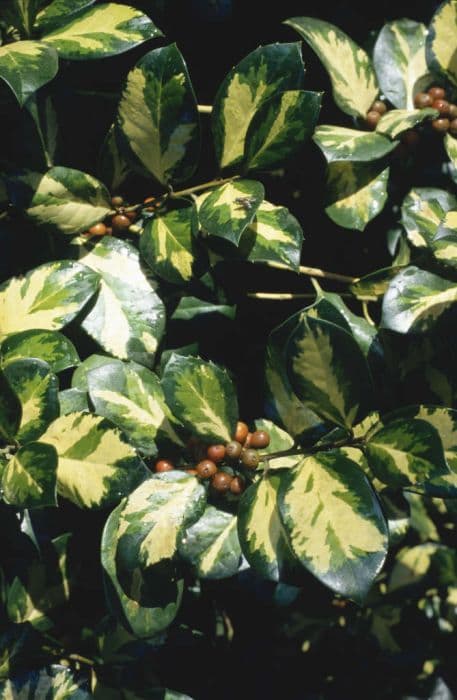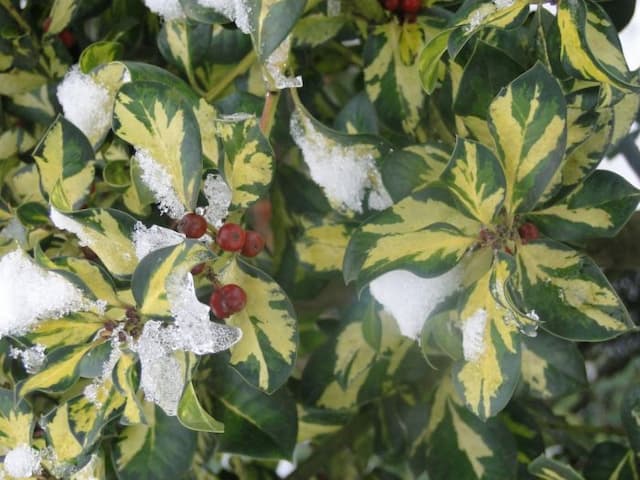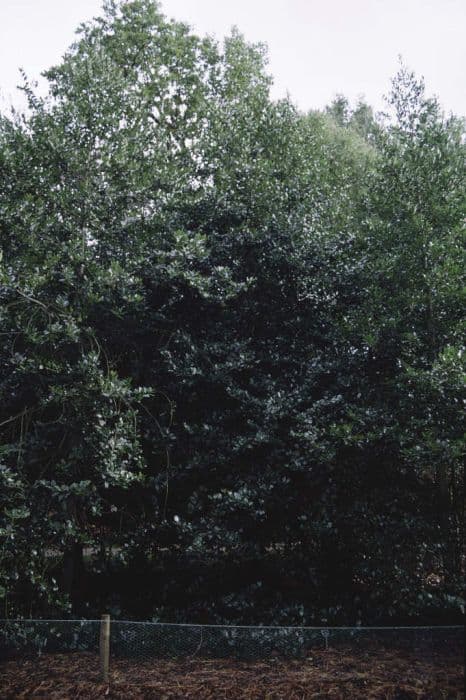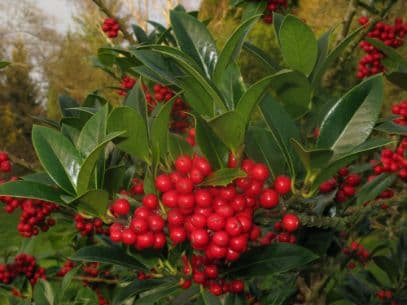Tarajo holly Ilex latifolia


ABOUT
Ilex latifolia is a large evergreen shrub or small tree that can grow up to 20 feet tall and wide.
It has glossy, dark green leaves that are 4-8 inches long and 2-4 inches wide. The leaves are leathery and have a smooth texture, with a sharp spine on the tip.
The small white flowers bloom in the spring and are followed by small, red berries that mature in the fall and persist through winter. The bark is smooth and gray, and the branches are thick and sturdy.
Overall, the plant has a dense and compact growth habit.
About this plant
 Names
NamesFamily
Aquifoliaceae
Synonyms
Tarajo, Tarajo holly, Broad-leaved holly, Tarajo holly, Lusterleaf holly, Inkberry, Gallberry, Japanese holly
Common names
Ilex macrophylla, Ilex tarajo
 Toxicity
ToxicityTo humans
Ilex latifolia is not considered toxic to humans.
However, it is always best to be cautious and keep all plants out of reach of children and pets to prevent accidental ingestion.To pets
Ilex latifolia is not considered toxic to animals.
However, as with any plant, it is always best to supervise pets when they are near any plants to ensure they do not ingest any parts of the plant.
 Characteristics
CharacteristicsLife cycle
Perennials
Foliage type
Evergreen
Color of leaves
Green
Flower color
White
Height
Up to 20 feet
Spread
Up to 20 feet
Plant type
Tree
Hardiness zones
5
Native area
Japan, China
Benefits
 General Benefits
General BenefitsIlex latifolia is an evergreen plant that provides visual interest in the garden throughout the year, even in the winter months;
The plant's dense foliage can be used to provide shade in the garden, making it an ideal choice for areas with hot summers;
The berries produced by the Ilex latifolia plant are a food source for birds and other wildlife, making it a great addition to gardens that are designed to attract wildlife;
Ilex latifolia is a relatively low-maintenance plant that is easy to care for, making it a great choice for gardeners of all skill levels;
This plant can be used in a variety of ways in the garden, including as a specimen plant, a hedge, or as a screen. Medical Properties
Medical PropertiesIlex latifolia has been traditionally used for medicinal purposes. The plant contains compounds such as flavonoids, triterpenoids, and tannins that have been found to have anti-inflammatory, antioxidant, and anti-cancer properties.
However, it is important to note that using Ilex latifolia as a stand-alone treatment is not recommended and consulting a specialist before using is necessary. The plant can cause skin irritation and allergic reactions in some individuals.
It is also not recommended for pregnant or breastfeeding women. Other Uses
Other UsesThe small leaves and compact growth habit of Ilex latifolia make it a popular choice for bonsai cultivation;
The dense branching structure of Ilex latifolia makes it well suited for shaping into topiary forms, such as spheres or cones;
Ilex latifolia can be planted as a hedge to provide privacy and block unwanted views;
Ilex latifolia is used to make Christmas decorations;
Beads from the berries are used to make jewellery.
Interesting Facts
 Plant Symbolism
Plant SymbolismIlex latifolia is commonly associated with the holiday season, particularly Christmas, due to its glossy, evergreen leaves and bright red berries.
It is also associated with winter and the concept of evergreen and eternal life.
In some cultures, it is also associated with good luck and protection.
 Water
WaterIlex latifolia prefers well-drained soil that is consistently moist, but not waterlogged.
Water the plant deeply about once a week, or more often in hot, dry weather. It is important to not let the soil dry out completely. Light
LightIlex latifolia can tolerate partial shade to full sun, but prefers partial shade.
It can tolerate full sun, but should be planted in an area with some protection from the hot afternoon sun. Temperature
TemperatureIlex latifolia is hardy in USDA zones 6-9, and can tolerate temperatures as low as -10°F when dormant. It can tolerate high temperatures, but prefers temperatures between 60°F and 70°F.
 Pruning
PruningPrune Ilex latifolia in late winter or early spring, before new growth begins. Prune out any dead, diseased, or damaged wood, and shape the plant as desired. If you're growing it as a hedge, shear it to shape after the new growth has hardened off and before it has set its flowers and fruit. If you're growing it as a specimen, selectively prune branches to achieve the desired shape.
 Soil
SoilIlex latifolia prefers well-drained, slightly acidic soil with a pH of 5.5 to 6.5.
It can tolerate a range of soil types, from sandy to clay, but it prefers a slightly acidic soil. If the soil is too alkaline, you can add sulfur to lower the pH. Humidity & Misting
Humidity & MistingIlex latifolia is tolerant of a wide range of humidity levels, but it prefers a moderate level of humidity.
It can tolerate dry air, but it may suffer from leaf drop if the air is too dry for an extended period of time. Suitable locations
Suitable locationsIndoor
Not growing
Outdoor
All year round.
Ilex latifolia is a hardy, evergreen plant that can be grown outdoors in a variety of conditions. It can tolerate temperatures as low as -10°F. It prefers mild winters and moderate summers.Hardiness zone
USDA 6 -11
 Life cycle
Life cycleThe life of the plant starts with germination. Germination typically occurs within a few weeks of sowing.
Seeding is the stage when the young plant is developing its first set of leaves. It is a delicate stage where the seedling should be protected from extreme temperatures and drought.
Juvinile period is when the plant begins to develop its adult characteristics, such as its final leaf shape, but it has not yet reached maturity.
And during maturnity, the plant will produce flowers and berries. Propogation
PropogationPropogation time
Fall, spring, summer
By SEEDS:
The best time to sow seeds is in the fall or early spring, when temperatures are cool. Sow the seeds in a seed tray filled with well-drained seed compost and cover with a layer of vermiculite. Keep the tray in a cool, bright place and keep the compost moist. Germination should occur within 4-6 weeks.
By CUTTINGS:
The best time to take cuttings is in the summer, when new growth is actively growing. Take semi-ripe cuttings, around 4-6 inches long, and remove the leaves from the lower half. Insert the cuttings into a propagating tray filled with a mixture of peat and sand. Keep the cuttings in a bright, but shaded place and keep the compost moist. Rooting should occur within 4-6 weeks.
By LAYERING:
The best time for layering is in the spring or summer, when new growth is actively growing. Choose a flexible, young shoot and bend it to the ground. Pin it in place and cover the area with soil. Keep the soil moist and new roots should form at the point where the stem is in contact with the soil. Once the roots have formed, the stem can be cut away from the parent plant and transplanted.
 Pests
PestsSpider mite, Scale insects
 Diseases
DiseasesRoot Rot, Powdery mildew









